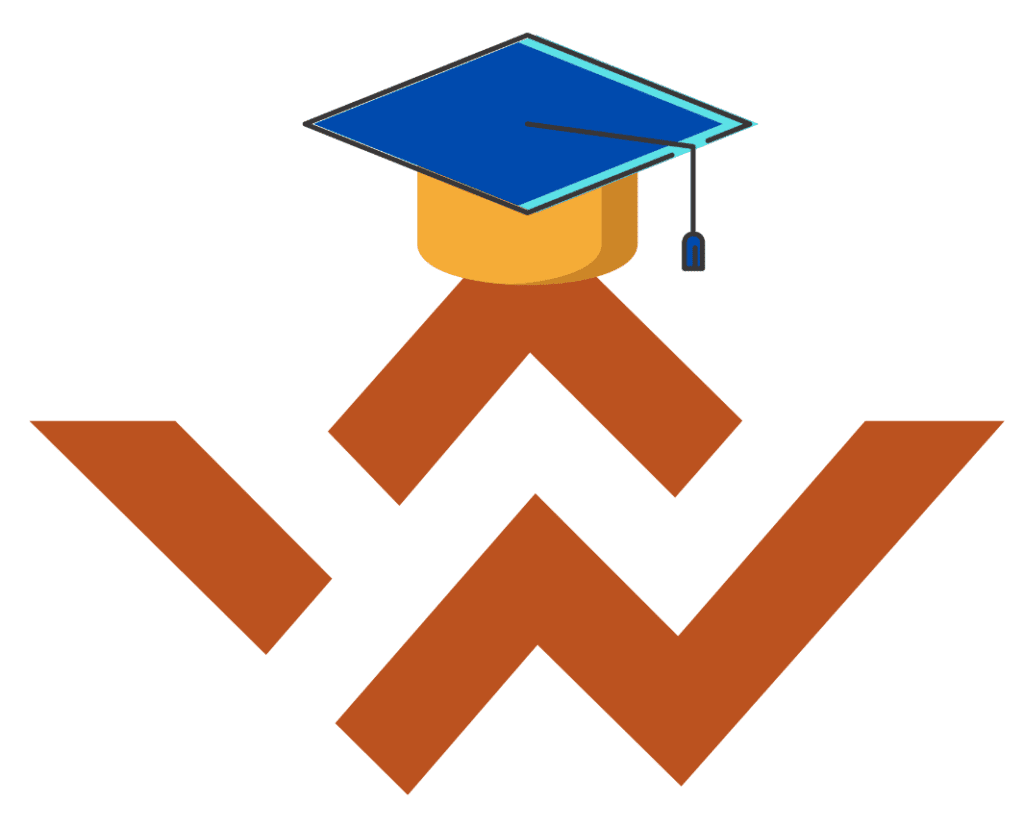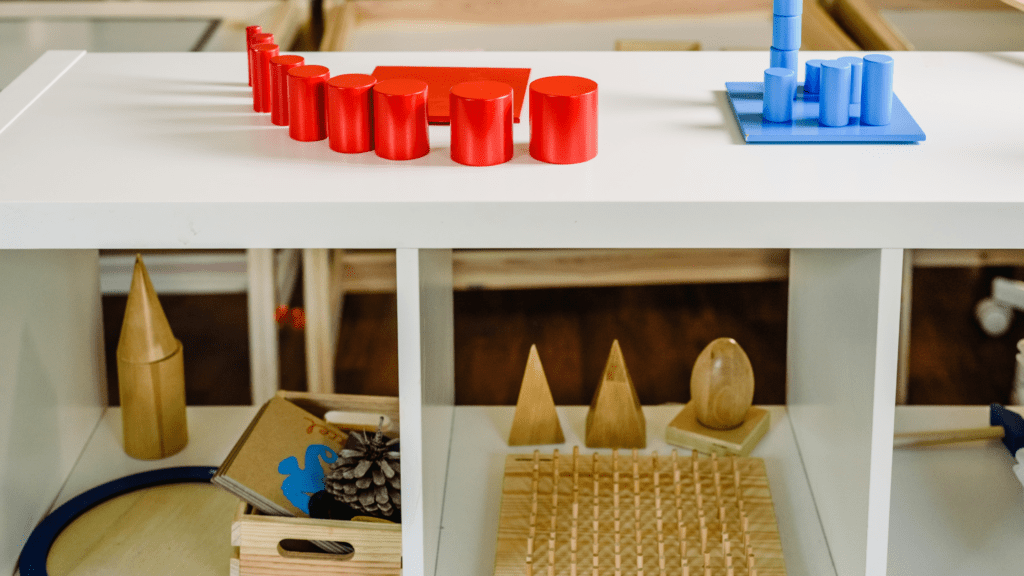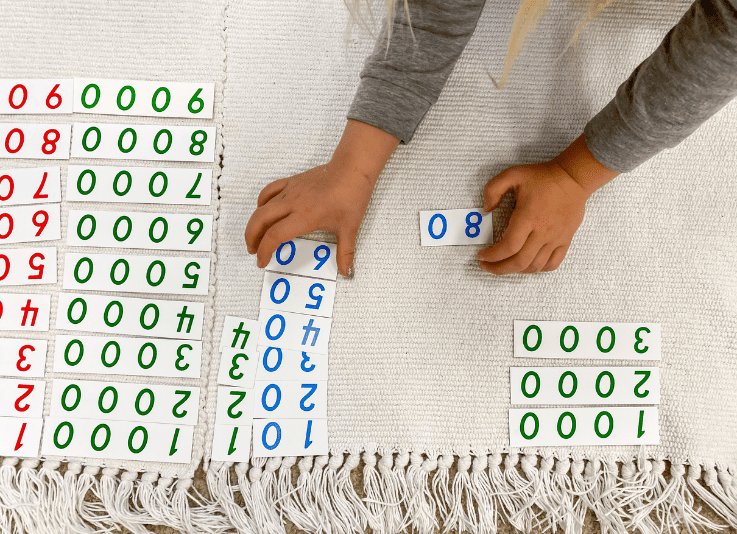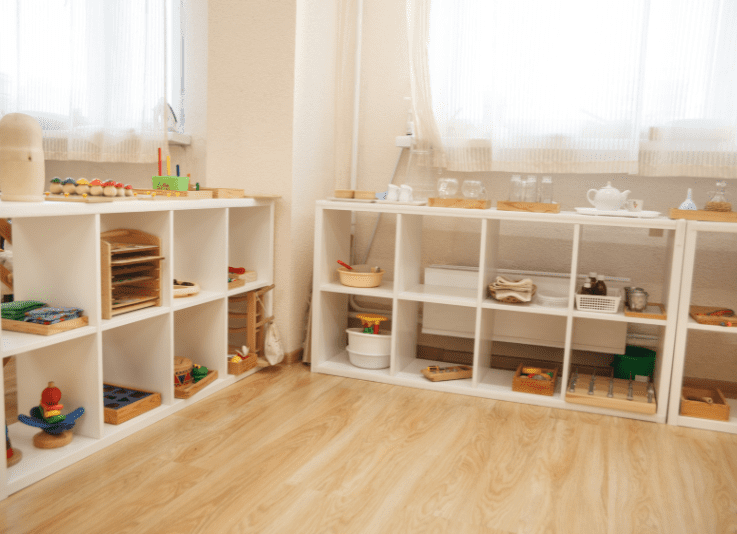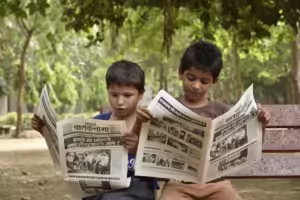As parents, we all want to know what our children will learn and do in the future. When picking an education system and board, it is important to check the curriculum they will study.
In our previous blog, we talked about what is Montessori education, and why it has become more popular in recent years in India. We also explained its principles, its benefits to parents and the child, its false criticism,and how it is different from traditional education. But have we thought about what the Montessori curriculum includes and how it helps children develop in all areas of life?
What is the Montessori Curriculum?
“Education is not something which the teacher does, but that it is a natural process which develops spontaneously in the human being. It is not acquired by listening to words, but in virtue of experiences in which the child acts on his environment. The teacher’s task is not to talk, but to prepare and arrange a series of motives for cultural activity in a special environment made for the child” – Maria Montessori
The Montessori curriculum is a hands-on approach to learning that encourages children’s natural curiosity. It focuses on developing independence, correcting errors, respecting others and the environment, and fostering creativity in a supportive setting. Montessori classrooms are designed to promote intelligence and development through materials and experiences tailored to children’s needs.
Sounds Interesting? If you are a parent or educator who is curious about this unique approach, you’ve come to the right place. In this article, we will examine the Montessori curriculum, including the topics and skills it covers, and the benefits it provides. So, let’s get started!
What are the Five Focus Areas of the Montessori Curriculum?
The Montessori curriculum is a comprehensive educational framework that covers various areas of development. It is designed to focus on five key areas of study:
1. Practical life skills

Thepractical life area of study focuses on helping children develop the everyday life skills they need to care for themselves and their environment. Activities in this area include things like dressing, grooming, cleaning, cooking, pouring, sorting, and more, which help in developing fine motor skills, hand-eye coordination, and concentration.
2. Sensorial development
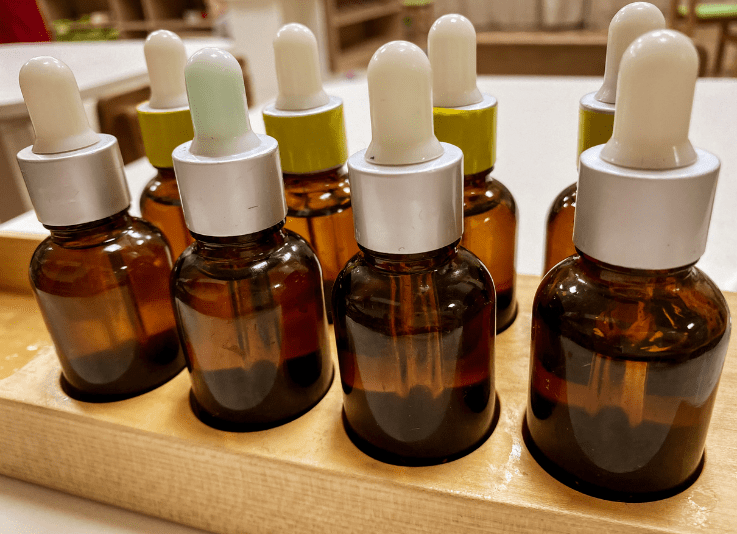
sensorial study aims to refine and develop children’s senses. It helps them learn to differentiate between different sensations, such as visual discrimination, tactile exploration, auditory perception, and olfactory awareness. The materials provide opportunities to classify and order objects by attributes like size, shape, color, texture, and sound. Montessori activities include touch fabrics, thermal tablets, smelling bottles, sound bells, and many more. Engaging in these activities will enhance a child’s curiosity through an immersive experience.
3. Language

The Language curriculum aims to develop language skills, including reading, writing, and speaking. Language activities in Montessori education encompass oral language skills, vocabulary enrichment, phonemic awareness, conversation, reading, and cursive writing. Materials like sandpaper letters, movable alphabets, rice trays, 3-part cards, and language games are used to support language acquisition and literacy development.
4. Mathematics
The mathematics curriculum is designed to help children develop their mathematical skills. This includes counting, as well as addition, subtraction, multiplication, division, and other complex concepts such as geometry and algebra. Montessori math materials are used to help children learn from concrete manipulative materials such as number recognition,number rods,bead bars, stamp games, decimal cards, binomial cubes, and more in a way that the concepts last long.
5. Cultural
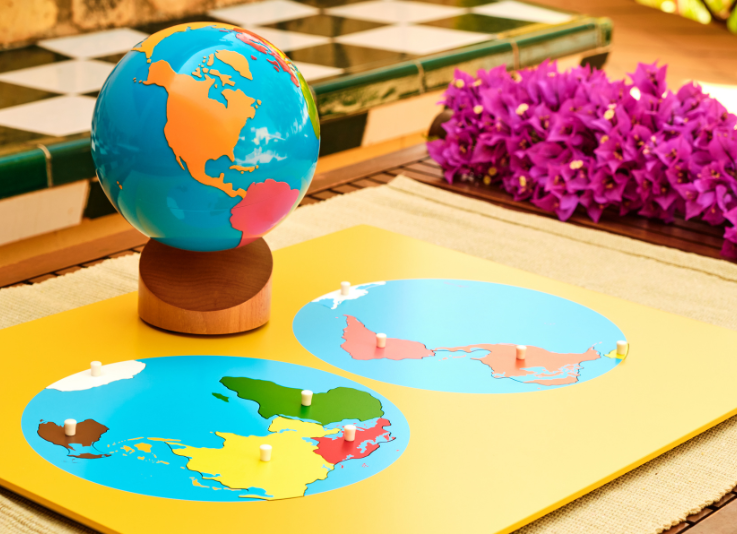
The Cultural Studies curriculum is designed to help children learn about the world around them, including geography, history, science, environment, grace and courtesy, music, art, foreign languages, and culture. It aims to learn about the world around them and its interconnectedness. The activities in this curriculum include tasks such as learning about the formation of the earth, life on earth, the solar system, exploring different cultures, learning about animals and plants, spatial awareness, and more.
Also Check: Top 10 Montessori Criticisms Debunked
Apart from the 5 focus areas, there are two more areas:
Developing social and emotional skills
Montessori education promotes harmony education, character development, and social-emotional skills. Children learn conflict resolution, empathy, respect, and responsibility towards others and the environment. Activities and discussions cultivate a peaceful classroom environment and a global perspective.
Gross Motor skills
The Montessori curriculum promotes a variety of activities, including music, art, physical education, field trips, nature walks, and more. These activities are designed to develop the gross motor skills of children.
In essence, the Montessori curriculum is flexible and adaptable to the unique needs of each child. It is often tailored to meet the developmental needs and interests of individual students, with the aim of cultivating a lifelong love of learning.
What is Included in Montessori Curriculum?
Foundational Montessori organizations provide continuous guidance on structuring the Montessori curriculum, with a focus on keeping the child at the center. As we have discussed in previous blogs, Montessori school programs are designed for all age groups, from infants to adolescents. Montessori schools have multi-age classrooms arranged as follows:
- Infant: 0-18 months
- Toddler:1-3 years
- Early Childhood: 3-6 years
- Elementary: 6-12 years
- Secondary: 12-18 years
Let us now understand how the Montessori curriculum is structured for each age group.
- Infant/Toddler Program (0-3 years):
The Montessori curriculum for toddlers is founded on six interwoven areas of development: sensory and perceptual, physical, cognitive, gross and fine motor skills, self-care and personal development, and social and emotional skills.The toddler classroom should provide a progressive environment that promotes freedom of movement, integrates daily routines, and offers experiences that encourage children’s growth and independence, based on their needs, capabilities, and interests.
The activities offered include a wide range of engaging tasks, such as rolling a rug, walking gracefully on a line, diligently washing our hands, mastering pouring and transferring skills, honing fine motor skills with dressing frames, taking care of clothes by washing and folding them, developing cognitive skills through sorting by color, size, and shape, and captivating phonics learning with a fun game of “I spy.” And these are just a glimpse of the many captivating activities we have in store for you!
- Early Childhood / Primary Program (3-6 years):
The Primary Program is the most well-known and widely implemented Montessori program. It serves children from ages 3 to 6 and is typically offered in preschool and kindergarten settings. During early childhood, the Montessori curriculum expands upon the skills and activities acquired during the toddler stage. It encompasses a wide range of subjects, including practical life skills, sensorial activities, math, spoken language, reading and writing, peace and cosmic education, cultural studies, art, and music. It provides more complex activities and materials. The child-centered curriculum emphasizes self-efficacy, independence, motion, sensory perception, language, and cognitive development. Children are given the freedom to pursue their interests, choose their activities, and proceed at their own pace, developing abilities in reasoning, imagination, and sociability.
Activities included: threading and sewing, sound bells, baric bars, raking, moveable alphabets, sandpaper letters, open and close, color tablets, bead bars, washing and cleaning, three-part cards geometric solids, constructive triangles, globes and puzzle maps, rhythmic instruments, science concepts like sink and float, animal classification, and many more.
- Elementary Program (6-12 years):
The Montessori Elementary Program offers an enriching educational experience for children aged 6 to 12. This program facilitates their growth into critical thinkers who engage in abstract reasoning, solve complex problems, and develop a deep understanding of concepts such as justice, empathy, and the social environment. The program emphasizes interdisciplinary and project-based learning, where children engage in advanced work across various subjects, including language arts, mathematics, geometry, history, science, geography, arts, and social skills.
The curriculum cultivates children’s innate desire to make a difference in the world, helping them develop a sense of humanity. It also allows children to explore their hobbies and become proficient in fundamental abilities and information. The learning environment is child-centered, supporting the development of focus, independence, cooperation, and teamwork, as well as organizational and time-management skills.
Activities included: bank game / colored bead bars for introducing addition, subtraction, multiplication, and division, coming of life, life cycles, research on various cultural and science concepts, exploration and field trips, experiments, geometric concepts such as Pythagoras theorems and many more.
- Adolescent Program (12-18 years)
The secondary or adolescent program is also known as the Montessori Erdkinder program. It is this program is designed for children between the ages of 12–18 years. Apart from four developmental stages: physical, emotional, social, and cognitive, the curriculum addresses the full spectrum of adult life. It recognizes the unique developmental needs of this age group and emphasizes real-world experiences, community engagement, entrepreneurship, and academic pursuits.
The curriculum includes academic studies, vocational training, creative arts, outdoor education, internships, and civic engagement. Children participate in complex projects that promote time management, organization, independent decision-making, problem-solving, community building, and the application of learning. The curriculum helps children get ready for college or work by promoting self-improvement, reflection, and leadership, while also teaching responsibility.
How Does Montessori Curriculum Benefit the Child?
Dr. Angeline S. Lillard mentioned in her book, An Answer to the Crisis in Education, on the Montessori curriculum.
The Montessori curriculum is meticulously organized, offering a wealth of materials and activities to capably guide children in honing their cognitive, social, and emotional abilities.The materials are meticulously crafted to provide a delightful combination of difficulty and entertainment, presented in a manner that empowers children to learn at their own rhythm. Montessori teachers are trained to observe children and to provide them with the guidance and support they need to learn effectively.
Studies have shown that children who attend Montessori schools consistently outperform children who attend traditional schools on measures of academic achievement, social skills, and self-regulation. Montessori schools are also more likely to have high levels of parent satisfaction.
If you are looking for a high-quality educational program for your child, I highly recommend considering a Montessori school.”
Here are some of the benefits of the Montessori curriculum that Dr. Lillard mentions in her book:
- Academic achievement: Studies have shown that children who attend Montessori schools consistently outperform children who attend traditional schools on measures of academic achievement, such as math, reading, and science.
- Social skills: Montessori schools emphasize social and emotional development, and studies have shown that children who attend Montessori schools are more likely to have strong social skills, such as cooperation, empathy, and conflict resolution.
- Self-regulation: Montessori schools help children develop self-regulation skills, such as the ability to focus, control their emotions, and manage their time.
- Parent satisfaction: Studies have shown that parents of children who attend Montessori schools are more likely to be satisfied with their children’s education.
Final Words
Montessori curriculum is surely structured based on the developmental needs of children and many researches have proved its effectiveness. Parents seeking an exceptional education for their children should seriously consider enrolling them in a Montessori school. In this nurturing and intellectually stimulating environment, their child will not only flourish but also experience unparalleled growth. If you still have a doubt, contact us or visit a Montessori school to see for yourself.
FAQs on Montessori Curriculum
What is the Montessori curriculum?
The Montessori curriculum is an educational approach which was developed by Dr. Maria Montessori in the early 20th century. Montessori is a child-centered educational philosophy and system that focuses on individualized learning, self-directed exploration, and the development of a child’s natural abilities and interests. The Montessori curriculum is widely used in preschools and early childhood education, but it can also extend into elementary and even secondary education.
What are the 5 Montessori methods?
The Montessori method is a holistic educational approach that emphasizes child-centered learning and individualized instruction. Here are the 5 methods of Montessori-
- Prepared Environment
- Mixed-Age Grouping
- Montessori Materials
- Self-Directed Learning
- Observation and Individualization
What is the Montessori curriculum based on?
The Montessori curriculum is base on many key principles and philosophies on base of child education. it is designed to align with the development needs and characters of children. The curriculum is rooted in the work and research of Dr. Maria Montessori, an Italian physician and educator who developed the Montessori method in the early 20th century. The Montessori curriculum is based on the following principles:
What is a key component of the Montessori curriculum approach?
The key components of the Montessori are mentioned below-
- Concrete and Self-Correcting
- Isolation of Concept
- Control of Error
- Sequential Progression
- Hands-On Learning
- Freedom of Choice
